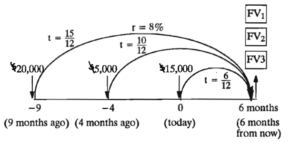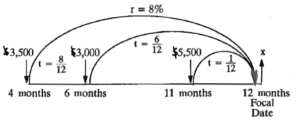Solutions to Chapter 3 Knowledge Checks
Knowledge Check 3.1
- P = $3,000; r = 6% = 0.06; t =180/365 years [latex]I=Prt=$3,000\times0.06\times\frac{180}{365}=$88.77[/latex]
- I=$55; r =5.5%=0.055; t =125/365 years [latex]P=\frac{I}{rt}=\frac{$55}{0.055\left(\frac{125}{365}\right)} =$2920.00[/latex]
- P = $900, I = $65, r = 7.5% = 0.075
[latex]t=\frac{I}{Pr}=\frac{$65}{$900\times 0.075}=0.962963\text{ years}[/latex]
To convert this answer to days, you must multiply by 365. To eliminate a rounding error, be sure to use the exact value from your calculator, i.e., just multiply the above value by 365 without re-entering the displayed value .
[latex]∴ t =\frac{$65}{$900\times0.075}\text{years}\times \frac{365\text{ days}}{1\text{ years}} = 351.48\text{ days}[/latex]
This should now be rounded up to 352 days.
- P = $975, I = $36.73, t =220/365 years
[latex]r=\frac{I}{Pt}=\frac{$36.73}{$975\left(\frac{220}{365}\right)} = 0.062500932 = 6.25%[/latex]
Knowledge Check 3.2
- P = $4,000, r = 8% = 0.08, t = 210/365 years

[latex]FV=$4,000 \left[1 +0.08\left(\frac{210}{365}\right)\right][/latex]
- P = $1,250, r = 6.75% = 0.0675; [latex]t = (251 - 69)+365 =\frac{182}{365}[/latex] years (from Table 3- 1)

[latex]FV=$1,250\left[1 +0.0675\left(\frac{182}{365}\right)\right]=$1,292.07[/latex]
- P = $2,500, r = 3.75% = 0.0375, t = 2 years

[latex]FV =$2,500 (1 +0.0375\times 2)= $2,687.50[/latex]
Knowledge Check 3.3
- P = $2,000, FV = $2,210, t = 1.5 years

Either of the two following approaches is acceptable:
Approach A:
[latex]I = FV - P =$2,210 -$2,000 =$210[/latex]
So
[latex]r=\frac{I}{Pt}=\frac{$210}{$2,000\times1.5}=0.07=7%[/latex]
Approach B:
[latex]r = \frac{\frac{FV}{P}-1}{t} = \frac{\frac{$2,210}{$2,000}-1}{1.5}= 0.07[/latex]
- FV = $1,871.25, r = 9% = 0.09, t = 33 months =33/12 years.

[latex]P=\frac{FV}{1+rt}=\frac{$1,871.25}{1+0.09\times \left(\frac{33}{12}\right)}=$1,500.00[/latex]
Knowledge Check 3.4
a. Find FV at 7%:

[latex]FV = P(1+rt) = $10,000 \left(1+0.07×\frac{6}{12}\right) = $10,350[/latex]
Conclusion: The value of $10,000 now, in six months’ time is $10,350. Since this is $25 greater than $10,325, you would prefer $10,000 now from a purely financial point of view.
b. Find FV at 6%:

[latex]FV = P(1+rt) = $10,000 \left(1+0.06×\frac{6}{12}\right) = $10,300[/latex]
Conclusion: The value of $10,000 now, in six months time is $10,300. Since this is less than $10,325, you would prefer $10,325 in six months time.
Knowledge Check 3.5

[latex]\begin{align*} &FV_1=$20,000\left(1+0.08\times\frac{15}{12}\right)=$22,000.00\\ &FV_2=$5,000\left(1+0.08\times\frac{10}{12}\right)=$5,333.33\\ &FV_3=$10,000\left(1+0.08\times \frac{6}{12}\right)=$10,400.00\\ \end{align*}[/latex]
Total Debt Outstanding = $37,733.33(6 months from now)
Knowledge Check 3.6
1.

[latex]PV=\frac{$5,000}{1+0.09\times \frac{19}{12}}=$4,376.37[/latex]

[latex]\begin{align*} &PV_1=\frac{$2,000}{1+0.07\times \frac{7}{12}}=$1,921.54\\ &PV_2=\frac{$4,000}{1+0.07\times \frac{13}{12}}=$3,718.05 \end{align*}[/latex]
Total Equivalent Debt Now = $5,639.59
Knowledge Check 3.8

Value of “old” payments at the focal date :
[latex]$3,500\left(1+0.08\times \frac{8}{12}\right)+$5,500\left(1+0.08\times \frac{1}{12}\right)[/latex]
[latex]=$3,686.67+$5,536.67=$9,223.33[/latex]
Value of “replacement” payments at the focal date:
[latex]$3,000\left(1+0.08\times \frac{6}{12}\right)+x=$3,120+x[/latex]
Therefore:
[latex]$3,120+x=$9,223.33[/latex]
[latex]x =$9,223.33 -$3,120.00=$6,103.33[/latex]
Knowledge Check 3.9

Let the amount of two equal payments be x. Value of “old” payments at the focal date:
[latex]$10,000\left(1+0.09\times \frac{4}{12}\right)+\frac{$9,000}{\left(1+0.09\times \frac{2}{12}\right)}[/latex]
Value of “replacement” payments at the focal date:
[latex]x+\frac{x}{\left(1+0.09\times \frac{6}{12}\right)}[/latex]
And we can set these to be equal:
[latex]x+\frac{x}{\left(1+0.09\times \frac{6}{12}\right)} = $10,000\left(1+0.09\times \frac{4}{12}\right)+\frac{$9,000}{\left(1+0.09\times \frac{2}{12}\right)}[/latex]
And solve, remembering to store all intermediate values in the calculator:
[latex]\begin{align*} x+\frac{x}{1.045} &=$10,000(1.03)+\frac{$9,000}{1.015}\\ x\left(1+\frac{1}{1.045}\right)&=$10,300+$8866.995074\\ x&=\frac{$19,166.995074}{1.956937799}=$9,794.38 \end{align*}[/latex]
Therefore: The size of the two equal payments is $9,794.38.

